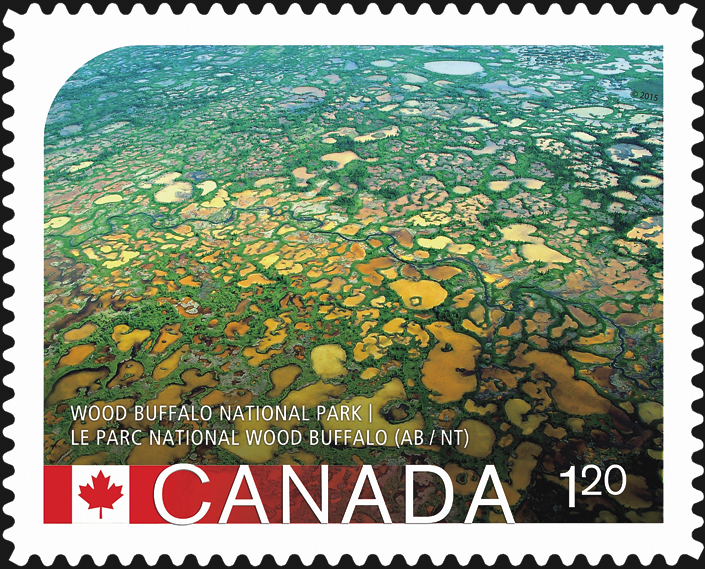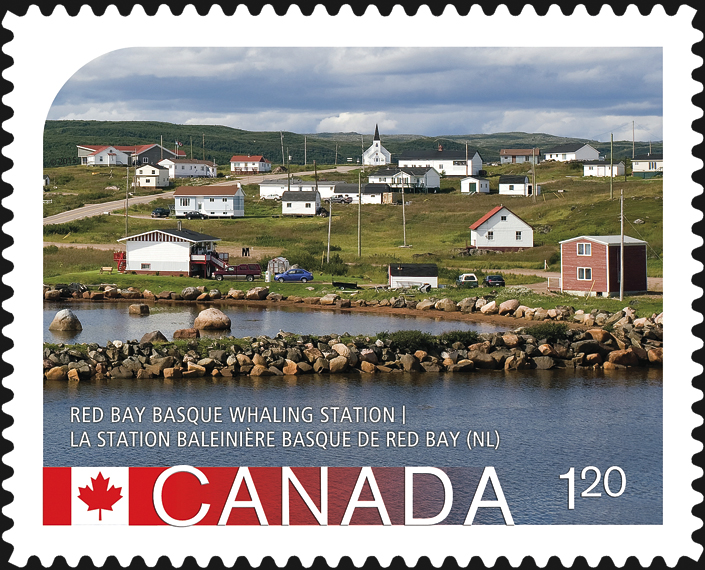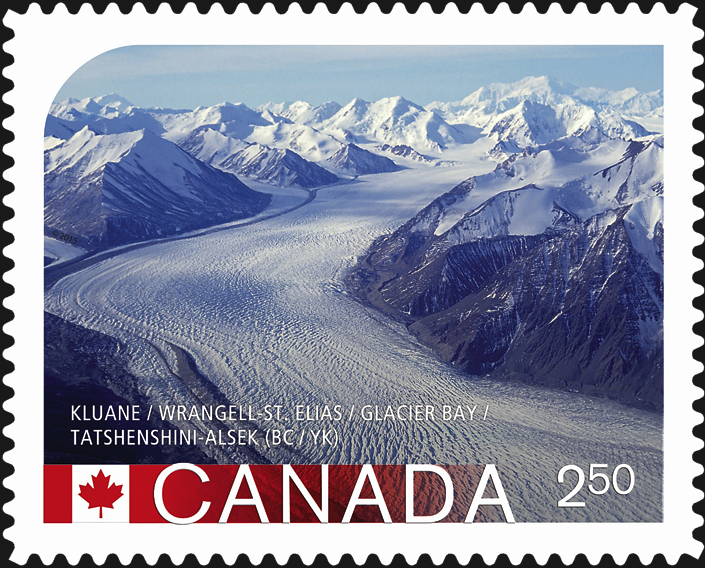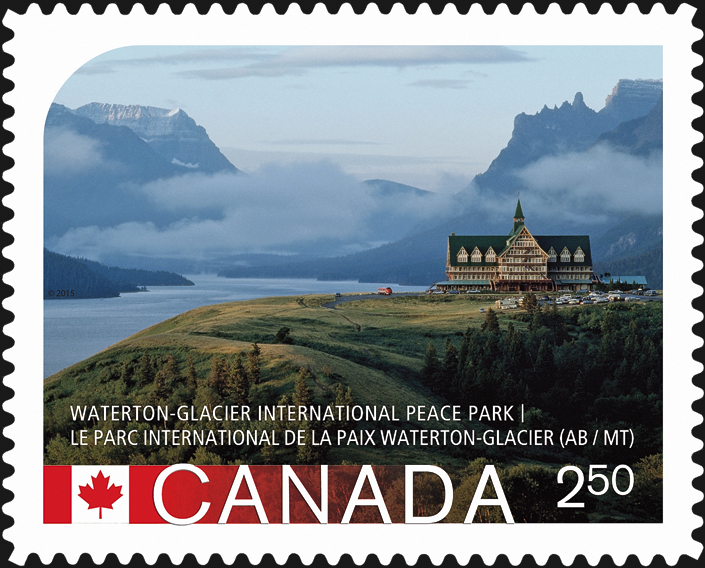World Stamps
Canada-U.S. parks on July 3 UNESCO Heritage Sites stamps
By Fred Baumann
Two $2.50 stamps saluting parks that span the United States-Canadian borders and unite our peoples are among the five face-different July 3 designs in Canada’s UNESCO World Heritage Sites series.
The stamps celebrate places listed by the United Nations Educational, Scientific and Cultural Organization as being of exceptional cultural or physical significance.
Begun last year with 10 face-different stamps, Canada’s philatelic tour continues July 3 with this third issue composed of three $1.20 U.S.-rate and two $2.50 international-rate stamps.
Canada Post says the UNESCO Heritage Site series will continue with a fourth issue of “permanent” (85¢) domestic-rate commemoratives later this year, “in response to many requests we’ve received over the years for stamps that depict the natural and cultural beauty of our country.”
A $2.50 international-rate stamp in the July 3 issue pictures a massive glacier in the first transborder site ever named by UNESCO, which straddles a rugged and remote region of Alaska, Yukon Territory and British Columbia.
Home to most of the tallest peaks in North America and the largest ice field outside of the polar caps, Kluane National Park and Reserve and Tatshenshini-Alsek Park are the Canadian components of a vast, unbroken ecological unit that covers 37,450 square miles — an area larger than Indiana — yet a region so challenging that the only human interaction with the land is “an historic Aboriginal presence.”
The U.S. components of the site are Alaska’s Wrangell-St. Elias National Park and Preserve and Glacier Bay National Park and Preserve.
A second $2.50 stamp shows a scenic corner of the Waterton-Glacier International Peace Park, the first of its kind in the world to promote peace and friendship between nations.
The idea to unite Montana’s Glacier National Park and Alberta’s Waterton Lakes National Park began as early as 1911 when, according to Parks Canada, “Waterton’s first park official, John G. ‘Kootenai’ Brown, forged a friendship with Henry ‘Death on the Trail’ Reynolds, an American Ranger from Goat Haunt, MT … Both men felt that the upper Waterton valley, which is intersected by the Canada/US border, could not and should not be divided.”
In 1932, the parks combined as the Waterton-Glacier International Peace Park.
An international herd of elk migrates annually between a summer mountain habitat in Glacier and winter prairie ranges in Waterton. An aboriginal presence dates back at least 12,000 years, and in both parks remain places that hold deep significance for First Nations peoples.
In fact, Waterton-Glacier International Peace Park stands on the land of three nations: Canada, the United States and the Blackfoot Confederacy.
Panes of six, three each of these $2.50 stamps celebrating Canada-U.S. parks issued July 3, should be of interest to Canadian and American collectors alike.
Ironically, because the stamps pay Canada’s international mail rate — more than twice the $1.20 rate for a letter from Canada to the United States — few are likely to ever be used on mail between the two nations.
Three other new UNESCO Heritage Sites stamps pay Canada’s $1.20 rate to the United States.
One otherworldly design depicts the columns of naturally weathered rock known as hoodoos of Dinosaur Provincial Park, in the badlands of southeastern Alberta.
Since the 1880s, the park has seen the discovery of 300 fossils of more than 40 dinosaur species dating as far back as 75 million years.
The retreat of the last ice age about 13,000 years ago created the Red Deer River Valley, along with the hoodoos, isolated mesas and low-lying coulees of the badlands. It also left the Earth’s greatest concentration of rare Late Cretaceous fossils, concentrated in a 17-mile stretch along the river — remains now showcased in museums around the world.
Canada’s largest national park, Wood Buffalo National Park, is the embodiment of northern Canada. Its 17,300 square miles encompass boreal forest and plains and some of the largest undisturbed grass and sedge meadows left in North America.
These meadows sustain the world’s largest free-roaming herd of bison, the nesting habitat of the world’s last remaining wild migratory flock of whooping cranes, and some nesting sites of the peregrine falcon.
In 2013, UNESCO chose Red Bay Basque Whaling Station as the newest site on its World Heritage List. In the 16th century, whalers from France and Spain came to the coast of Labrador near the northern tip of Newfoundland to hunt the right and bowhead whales then plentiful in those waters, which supported a thriving whale oil industry.
Also a National Historic Site of Canada, Red Bay houses the remains of rendering ovens, cooperages, workshops, temporary dwellings, wharves and whale bones. Underwater rest the remains of vessels exemplifying 16th-century European shipbuilding techniques, including four whaling ships and smaller boats.
The 2015 UNESCO World Heritage Sites stamps were designed by Lara Minja of Lime Design in Edmonton, Alberta.
The photographs featured on the stamps were supplied by Mike Todor Photo of Travel Drumheller (Dinosaur Provincial Park); John McKinnon of Parks Canada (Wood Buffalo National Park); destinationlabrador.com (Red Bay Basque Whaling Station); Lowell Georgia of National Geographic Creative (Waterton-Glacier International Peace Park); and Altrendo Nature of Getty Images (Kluane/Wrangell-St. Elias/Glacier Bay/Tatshenshini-Alsek).
The horizontally formatted stamps measure 54 millimeters by 85mm, have PVA gum, and were printed in four-color offset lithography by Lowe Martin.
Two examples each of three different $1.20 stamps paying the basic Canadian letter rate to the United States appear in a $7.20 booklet of six, Canada Post item 413982111.
Three examples each of two different $2.50 stamps paying the basic Canadian letter rate to international addresses appear in a $15 booklet of six, Canada Post item 413983111.
All these booklet stamps appear to be rouletted, self-adhesive issues in images supplied by Canada Post. Canada Post is printing 160,000 of each booklet. That’s 480,000 of each of the $2.50 booklet stamps, and 320,000 of each of the $1.20 booklet stamps.
All five of the face-different stamps also are available in an $8.60 souvenir sheet measuring 130mm by 100mm, Canada Post item 403982145, of which 140,000 have been printed.
In the image of the souvenir sheet supplied by Canada Post shown nearby, these stamps appear to be perforated, presumably with moisture-activated gum.
Measuring 191mm by 113mm, an official first-day cover of the souvenir sheet with all five face-different designs at $9.60 is Canada Post item 403982144.
The FDCs are canceled at Red Bay, Newfoundland, site of the Red Bay Basque Whaling Station, which dates back to the 1530s.
Canada Post also is offering international-rate picture postal cards of all five of the stamp designs for $2.50 each, or they may be purchased at $12.50 for a set of five as Canada Post item 262437.
Canada Post products are available at its online store. Stamps and FDCs will be available by mail order from the National Philatelic Centre, Canada Post Corp., 75 St. Ninian St., Antigonish, NS B2G 2R8, Canada; or by telephone from the United States and Canada at 800-565-4362, and from other countries at 902-863-6550.
Canada’s stamps and stamp products are also available from many new-issue stamp dealers, and from Canada Post’s agent in the United States: Interpost, Box 420, Hewlett, NY 11557.
MORE RELATED ARTICLES
Headlines
-
US Stamps
Oct 7, 2024, 3 PMMcMurtrie dismissed as APS education director following Sept. 21 arrest
-
US Stamps
Oct 7, 2024, 12 PMVasiliauskas named president of Mystic Stamp Co.
-
US Stamps
Oct 6, 2024, 5 PMApgar souvenir card available
-
US Stamps
Oct 6, 2024, 4 PMFirst Continental Congress and U.N. stamps receive Scott catalog numbers











